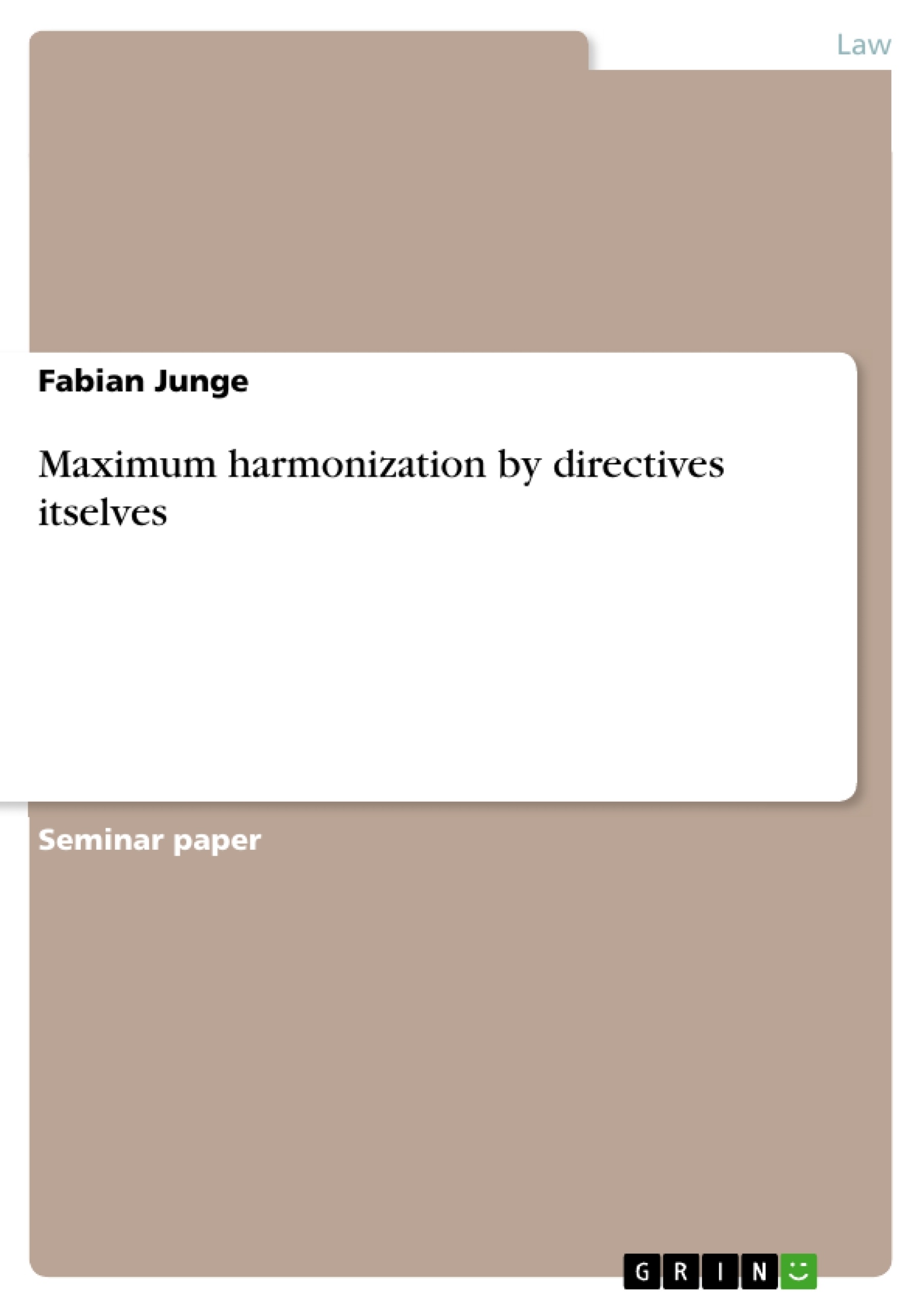The subject of harmonization and especially the seemingly never-ending discussion about its intensity and ways of achievement have been recurring topics within the history and development of various legal systems all over the world. Since the Middle Ages the notion is found that peace-keeping and an improvement of social and economic criteria can be reached through integration and approximation of various national legal systems.1 The European Union is herein no exception as it will be discussed in section B. As a logical conclusion of this long term development, it is obvious that the issue of harmonization includes a broad variety of difficult legal aspects that has been and will be examined by a large number of lawyers and courts. This paper will put the focus on maximum harmonization by directives itselves. But what is meant by the term maximum harmonization? In order to answer this question, there will be given a short overview of the general idea behind harmonization. Furthermore, the paper will provide an introduction to the theoretical concept of maximum harmonization. As one might observe during the analysis of the first part, the bulk of the problems arise around the relationship between the competences of the European legislator and the different national legislators. The pivotal question of this work therefore is: “How much leeway is left to the Member States of the European Union by implementing a European maximum harmonizing directive into the national legal order in case of doubt?”
The research will be rooted in the field of unfair competition law and in particular with comparative advertising, which is currently a highly controversial field regarding the aspects of harmonization due to the fact that there is a multiplicity of regulatory approaches in the Member States. 2To point out the cruxes of the question with reference to the chosen field of law and to illustrate the concept of maximum harmonization, a relatively recent case between O2 Holdings Ltd. and Hutchison 3G UK Limited3 will serve as object of investigation. In the end, there will be some final remarks on the topic of harmonization in the European Union in general.
Inhaltsverzeichnis (Table of Contents)
- A. Introduction
- B. The European approach to harmonization
- I. In general
- II. Determination by interpretation
- III. Scope and degree of the harmonization
- IV. Implementation in the national legal order
- V. Development in the EU
- C. Comparative advertising
- I. In General
- II. Case Study: 02 v. H3G - C-533/06
- 1. Facts of the case
- 2. Legal background
- 3. The relationship between Directive 2006/114/EC and Directive 2008/95/EC
- 4. The requirement of necessity
- 5. Section 10(6) of the Trade Marks Act 1994
- 6. Summary
- D. Final remarks
Zielsetzung und Themenschwerpunkte (Objectives and Key Themes)
This term paper explores the European approach to harmonization of law through the lens of comparative advertising, specifically examining the interaction between Directive 2006/114/EC and Directive 2008/95/EC. It aims to analyze the interplay between harmonization, interpretation, and implementation in the national legal order.
- The European approach to harmonization of law
- The impact of harmonization on national legal orders
- Comparative advertising and its regulation within the European Union
- The interpretation and application of EU directives in national legal systems
- The role of case law in shaping the understanding of EU law
Zusammenfassung der Kapitel (Chapter Summaries)
- A. Introduction: This chapter provides an introduction to the topic of the term paper, outlining the scope and purpose of the research. It discusses the relevance of harmonization in the context of the internal market.
- B. The European approach to harmonization: This chapter examines the general principles and strategies employed by the European Union in harmonizing national laws. It delves into the process of interpretation, the scope and degree of harmonization, and the implementation of EU directives within member states. Additionally, it highlights the evolution of the EU's harmonization approach over time.
- C. Comparative advertising: This chapter focuses on the specific area of comparative advertising. It examines the relevant legal framework, including Directive 2006/114/EC and Directive 2008/95/EC. The chapter also presents a case study of the 02 v. H3G case, analyzing the interaction between these directives and the interplay between EU and national law.
Schlüsselwörter (Keywords)
This paper focuses on the key terms and concepts of European Union law, specifically in the areas of harmonization, comparative advertising, and the interpretation of EU directives. The focus areas include the relationship between EU law and national legal orders, the role of case law in shaping the understanding of EU law, and the challenges of implementing harmonization in practice.
- Arbeit zitieren
- Fabian Junge (Autor:in), 2011, Maximum harmonization by directives itselves, München, GRIN Verlag, https://www.grin.com/document/178387



